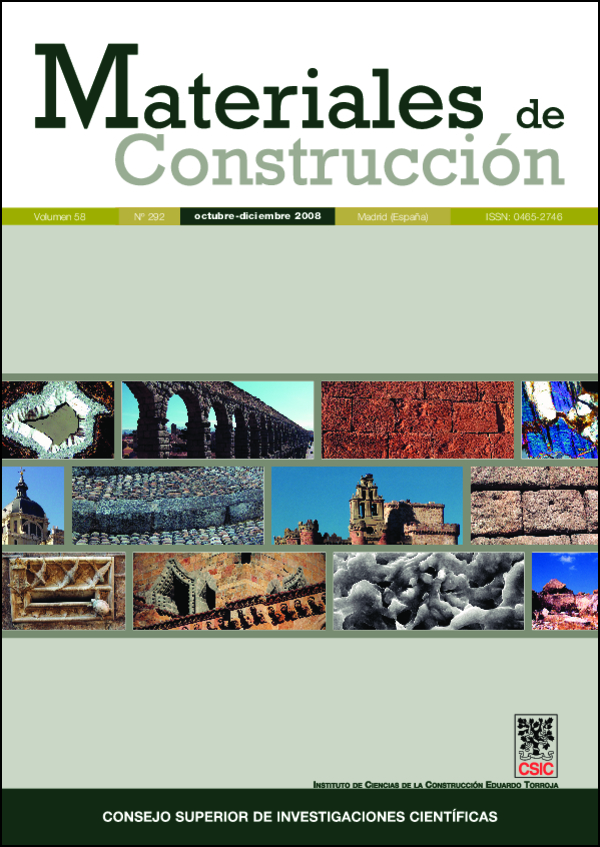Study of the shear behaviour of fibre reinforced concrete beams
DOI:
https://doi.org/10.3989/mc.2008.40507Keywords:
concrete, fibre reinforcement, flexural strength, compressive strength, mechanical propertiesAbstract
This study presents a series of tests for characterizing the structural behaviour of fibre reinforced concrete beams subjected to shear loading. The experimental program involves three types of fibres; two steel fibres and a polypropylene fibre. As a reference, plain concrete and conventionally reinforced concrete specimens have also been tested. The ultimate shear capacity of the beams is calculated and these values compared with those predicted by existing formulations. The study confirms that the toughness and shear crack resistance of the material is greatly enhanced by the fibres. However, the incorporation of 1% of fibres yielded lower shear strength than conventionally reinforced beams with the same amount of steel in the form of transversal stirrups. Existing design methods seem sufficiently robust to estimate the maximum shear load, even when using material properties (toughness, tensile strength) extrapolated from code formulae.
Downloads
References
(1) Almansa, E. M. and Canovas, M. F.: “Mix design of steel fiber reinforced concrete” Mater Construcc, Vol. 47, No 247-48 (1997), pp. 11-26.
(2) Al-Taan, S.A. and Al-Feel, J.R. “Evaluation of Shear Strength of Fiber-Reinforced Concrete Beams”, Cement and Concrete Composites, Vol. 12 (1990) pp. 87-94. doi:10.1016/0958-9465(90)90045-Y
(3) Casanova, P. and Rossi, P., “Analysis and Design of Steel Fiber Reinforced Concrete Beams”, ACI Structural Journal, Vol. 94, No. 5 (1997) pp. 595-602.
(4) Campione, G. and Mindess, S. “Fibers as Shear Reinforcement for High Strength Reinforced Concrete Beams Containing Stirrups”, Proceedings International Workshop on High Performance Cement Composites, HPFRCC3, Mainz, Germany (Eds. H.W. Reinhardt y A.E. Naaman) RILEM Publications S.A.R.L., Vol. 6 (1999) pp. 519-529.
(5) RILEM 'Test and design methods for steel fiber reinforced concrete: s-e Design Method', RILEM TC 162-TDF Recommendations, Materials and Structures, Vol. 33 (2000) pp. 75-81. doi:10.1007/BF02484159
(6) Dupont, D. and Vandewalle, L., 'Shear Capacity of Concrete Beams Containing Longitudinal Reinforcement and Steel Fibers' Proceedings ACI Fall Convention 2000, ACI-SP, American Concrete Institute, Detroit, USA. (2000).
(7) CNR-DT 204/2006, Guide for design, execution, and control of fibre reinforced concrete structures (Istruzioni per la Progettazione, l'Esecuzione ed il Controllo di Stutture di Calcestruzzo Fibrorinforzato), National Council of Research (Consiglio Nazionale delle Ricerche), Italy. (in Italian) (2006).
(8) RILEM “Test and design methods for steel fiber reinforced concrete: Bending Test” RILEM TC 162-TDF Recommendations, Materials and Structures, V. 33 (2000) pp. 3-5. doi:10.1007/BF02481689
(9) JSCE-SF5, “Method of Tests for Compressive Strength and Compressive Toughness of Steel Fibre Reinforced Concrete”, Recommendation for Design and Construction of Steel Fibre Reinforced Concrete. JSCE (1984).
(10) ASTM C 1018 - 97, “Standard Test Method for Flexural Toughness and First-Crack Strength of Fiber-Reinforced Concrete” (1998)
(11) Altun, F.; Haktanir, T.A. “Comparative experimental study of steel fibre-additive reinforced concrete beams” Mater Construcc, Vol. 54, No 276 (2004), pp. 5-15.
(12) Vandewalle, L. and Dupont, D., “Comparison between the Bending Tests According to RILEM, NBN, JCI, ASTM and the Uniaxial Tension Test”, Sub-task 2.3, Brite-Euram European Project BRPR.CT98.0813, “Test and design methods for steel fibre reinforced concrete”. (2001).
(13) EHE, Spanish Building Code (“Instrucción de Hormigón Estructural”), Ministerio de Fomento, Madrid. (in Spanish) (1999).
Downloads
Published
How to Cite
Issue
Section
License
Copyright (c) 2008 Consejo Superior de Investigaciones Científicas (CSIC)

This work is licensed under a Creative Commons Attribution 4.0 International License.
© CSIC. Manuscripts published in both the print and online versions of this journal are the property of the Consejo Superior de Investigaciones Científicas, and quoting this source is a requirement for any partial or full reproduction.
All contents of this electronic edition, except where otherwise noted, are distributed under a Creative Commons Attribution 4.0 International (CC BY 4.0) licence. You may read the basic information and the legal text of the licence. The indication of the CC BY 4.0 licence must be expressly stated in this way when necessary.
Self-archiving in repositories, personal webpages or similar, of any version other than the final version of the work produced by the publisher, is not allowed.
















